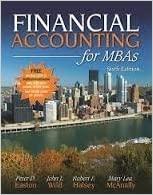Question
1 . Decentralized firms can delegate authority and yet retain control and monitor managers' performances by structuring the organization into so-called responsibility centers. Which one
1. Decentralized firms can delegate authority and yet retain control and monitor managers' performances by structuring the organization into so-called "responsibility centers." Which one of the following business segments/responsibility centers is most like an independent business?
Select one:
a. Revenue center
b. Profit center
c. Cost center
d. Profit and loss center
e. Investment center
2 Ally Mfg. uses a standard cost system and its July production of 1,800 units involved actual direct labor costs of $242,000 for 5,500 hours worked (AQ). The budget for July called for production of 2,000 units with 6,000 direct labor hours at $40.00 per hour (SP). Ally's direct labor efficiency variance for July is:
Select one:
a. $2,000 unfavorable
b. $4,000 unfavorable
c. $20,000 favorable
d. $22,000 unfavorable
e. $26,000 unfavorable
3. The King Mattress Company had the following operating results for 2015-2016. In addition, the company paid dividends in both 2015 and 2016 of $60,000 per year and made capital expenditures in both years of $30,000 per year. The company's stock price in 2015 was $8 and $7 in 2016. The industry average earnings multiple for the mattress industry was 9 in 2016 and the free cash flow and sales multiples were 18 and 1.5, respectively. The company is publicly owned and has 1,200,000 shares of outstanding stock at the end of 2016.
| Balance Sheet, Dec 31, | ||
|
| 2016 | 2015 |
| Cash | $340,000 | $100,000 |
| Accounts Receivable | $350,000 | $400,000 |
| Inventory | $250,000 | $300,000 |
| Total Current Assets | $940,000 | $800,000 |
| Long-lived Assets | 1,080,000 | 1,100,000 |
| Total Assets | $2,020,000 | $1,900,000 |
| Current Liabilities | $200,000 | $300,000 |
| Long-term Debt | 600,000 | 500,000 |
| Shareholder Equity | 1,220,000 | 1,100,000 |
| Total Debt and Equity | $2,020,000 | $1,900,000 |
| Income Statement, for year ended Dec 31, | ||
|
| 2016 | 2015 |
| Sales | $4,750,000 | $4,500,000 |
| Cost of Sales | 4,100,000 | 4,000,000 |
| Gross Margin | 650,000 | 500,000 |
| Operating Expenses | 350,000 | 400,000 |
| Operating Income | 300,000 | 100,000 |
| Taxes | 120,000 | 40,000 |
| Net Income | $180,000 | $60,000 |
| Cash Flow From Operations | 2016 | 2015 |
| Net Income | $180,000 | $60,000 |
| Plus Depreciation Expense | 50,000 | 50,000 |
| + Decrease (-inc) in AccRec. and Inv. | 100,000 | - |
| + Increase (-dec) in Cur. Liabl. | (100,000) | - |
| Cash Flow from Operations | $230,000 | $110,000 |
Return on equity for 2016 is (rounded):
Select one:
a. 11.6%
b. 14.6%
c. 15.5%
d. 18.9%
4. The internal rate of return (IRR) is the
Select one:
a. Rate of interest that equates the present value of after-tax cash outflows and the present value of after-tax cash inflows associated with a given project
b. Minimum acceptable rate of return for a proposed investment.
c. Risk-adjusted rate of return.
d. Required rate of return.
e. Weighted-average rate of return generated by internally generated funds.
5, The King Mattress Company had the following operating results for 2015-2016. In addition, the company paid dividends in both 2015 and 2016 of $60,000 per year and made capital expenditures in both years of $30,000 per year. The company's stock price in 2015 was $8 and $7 in 2016. The industry average earnings multiple for the mattress industry was 9 in 2016 and the free cash flow and sales multiples were 18 and 1.5, respectively. The company is publicly owned and has 1,200,000 shares of outstanding stock at the end of 2016.
| Balance Sheet, Dec 31, | ||
|
| 2016 | 2015 |
| Cash | $340,000 | $100,000 |
| Accounts Receivable | $350,000 | $400,000 |
| Inventory | $250,000 | $300,000 |
| Total Current Assets | $940,000 | $800,000 |
| Long-lived Assets | 1,080,000 | 1,100,000 |
| Total Assets | $2,020,000 | $1,900,000 |
| Current Liabilities | $200,000 | $300,000 |
| Long-term Debt | 600,000 | 500,000 |
| Shareholder Equity | 1,220,000 | 1,100,000 |
| Total Debt and Equity | $2,020,000 | $1,900,000 |
| Income Statement, for year ended Dec 31, | ||
|
| 2016 | 2015 |
| Sales | $4,750,000 | $4,500,000 |
| Cost of Sales | 4,100,000 | 4,000,000 |
| Gross Margin | 650,000 | 500,000 |
| Operating Expenses | 350,000 | 400,000 |
| Operating Income | 300,000 | 100,000 |
| Taxes | 120,000 | 40,000 |
| Net Income | $180,000 | $60,000 |
| Cash Flow From Operations | 2016 | 2015 |
| Net Income | $180,000 | $60,000 |
| Plus Depreciation Expense | 50,000 | 50,000 |
| + Decrease (-inc) in AccRec. and Inv. | 100,000 | - |
| + Increase (-dec) in Cur. Liabl. | (100,000) | - |
| Cash Flow from Operations | $230,000 | $110,000 |
The accounts receivable turnover ratio for 2016 is (rounded):
Select one:
a. 11.2
b. 12.7
c. 13.7
d. 14.9
Step by Step Solution
There are 3 Steps involved in it
Step: 1

Get Instant Access to Expert-Tailored Solutions
See step-by-step solutions with expert insights and AI powered tools for academic success
Step: 2

Step: 3

Ace Your Homework with AI
Get the answers you need in no time with our AI-driven, step-by-step assistance
Get Started


